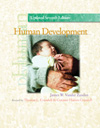 |  Human Development: Updated, 7/e James Vander Zanden,
Ohio State University
Thomas Crandell,
Broome Community College
Corinne Crandell,
Broome Community College
Early Childhood 2 to 6: Emotional and Social Development
Chapter OutlineChapter 7 focused on the expanding physical and cognitive competencies of preschool children. In Chapter 8, the early childhood years are once again examined, with primary emphasis on the process of emotional development and socialization. The main topics in Chapter include:
1Emotional Development. The ability to express more subtle emotions occurs as well as the ability to engage in forms of symbolic emotional communication such as play. |
 |  |  | 2The Development of Self. The development of self includes forms of self-awareness and self-esteem. |
 |  |  | 3Gender Identification. It is at this time that gender roles and gender identity begin to form. |
 |  |  | 4Family Influences. Specific parenting determinants and various child-rearing practices are discussed. Baumrind's four parenting styles and their effects on children's behavior are examined. Research is cited on effective parenting as well as on the sexual abuse of children. The impact of single-parent families and divorce on parents, as well as on children, is illustrated in detail. The final issue focuses on sibling relationships and their role in the socialization process. |
 |  |  | 5Peer Relationships. This section discusses children's peer relationships and friendships. The role of children as reinforcing agents and behavioral models for one another is examined, as is the importance of play in the child's personal and social development. The subject of aggression is addressed, with an emphasis on the effects of media violence on the behavior of the nation's youth. Finally, the impact of preschools and Head Start programs on both parents and children is summarized, and a guideline for selecting a preschool is presented. |
|



 2003 McGraw-Hill Higher Education
2003 McGraw-Hill Higher Education